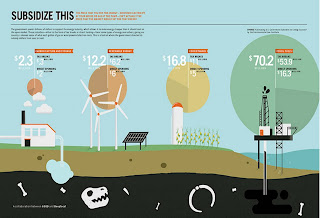Our project topic is about subsidizing renewable energy companies. In
our research, we primarily focused on the advantages of government granted direct subsides to renewable energy companies and our target
audience is towards the government, tax-payers, environmentalists, and the
people who are interested about why we should subsidize renewable
energy. The reason we chose to create a blog is because it’s an effective way to reach the various strata of our audience. In our blog we
included news articles, macro and micro-economic graphs, videos about
subsidizing renewable energy, satrical pictures and statistics all to show
our audience why subsidies are necessary in implementing green energy initiatives.
-Spencer Berry & Kelvin Han
Subsidizing Green
Sunday, December 18, 2011
Friday, December 16, 2011
Microeconomics: How Government Subsidies Work
Equilibrium Graph, a Perfect Market

(Yvan). Link: bestthinking.com
In economics, a perfect market is working in equilibrium when supply equals to demand. In economic terms, demand is the willingness of consumers to purchase a product/service at a given price. Supply is the willingness of producers to produce a product or service at a given price. We wanted to use this graph to show that imposing subsidies will still be able to achieve a perfect market and to show the economic effects of a government subsidy.
How Subsidies Work
A subsidy is an assistance paid to a business or economic sector.
(Panjwani). Link: econhelp.org
The graphs above show the effect of subsidies given by the government to producers. When a subsidy is granted, the supply curve shifts to the right to supply + subsidy. This causes an increase in quantity of goods/service produced to increase. (From the example above, 460 to 540). This causes a fall in price of the good (from $260-220). This should attract more consumers to purchase the product because it is cheaper. The area highlighted in green indicates the gain to buyers and the area in red highlights the gain to sellers. This is the overall effect of government subsidies.
Therefore, renewable energy needs subsidies to lower its price to allow people to have more access to green energy.
Thursday, December 15, 2011
Mechanism of Elasticities: Price Elasticity of Demand
"Price Elasticity of demand (PED) is the responsive of the quantity of a good or service demanded given a change in price. Price elasticity of demand is affected by the number of close substitutes for a good, the degree of necessity, trend, seasonal changes, and time. The greater the degree of the factors the more elastic the good or service will be, visa versa.
If a good or service is price elastic, an increase in price would cause a significant fall in quantity demanded for the specific good/service.
Conversely, if a good or service is price inelastic, an increase in price would cause a change in demand that will be proportionately smaller than the percentage change in price" (Microeconomics - Price Elasticity of Demand).
If a good or service is price elastic, an increase in price would cause a significant fall in quantity demanded for the specific good/service.
Conversely, if a good or service is price inelastic, an increase in price would cause a change in demand that will be proportionately smaller than the percentage change in price" (Microeconomics - Price Elasticity of Demand).
In effect, alternative renewable resources will cause the demand of fossil fuel to be more elastic because the number of substitutes to fossil fuels affects the demand for fossil fuels. In theory, this would increase the competition between renewable energy companies and fossil fuel companies.
The Story of Broke- Subsidies
The Story of Broke produced by The Story of Stuff and Free Range Studios, explains the main concepts of subsidies. It talks about the types of subsidies: Freebie Subsidies, Risk Transfer Subsidies, Spending and Tax Subsidies. In addition, most of these government subsidies are funded by taxpayers which helps us realize that taxpayers are also our target audience. Taxpayers are important because they have the right to decide what government should subsidize. This video helps our audience understand the importance of subsidies to the growth of renewable energy companies and towards maintaining a sustainable future. In our project, we mainly focus on government financial subsidies given to renewable energy companies so that the costs of producing renewable energy can be cheaper. This should make renewable energy cheaper for consumers.
Tuesday, December 13, 2011
History of Subsidies in the United States
"The federal government has provided an estimated $837 billion for energy development since 1950, according to a recent report. That includes money for tax concessions, for research and development, and the value of regulations (such as exemptions from price controls)
In fact, the government has played a role in energy investment through tax deductions, research grants and regulatory policies dating back to the days when timber was a major source of fuel.
Nancy Pfund is a venture capitalist investor in clean technologies, who co-authored a recent study that tallied the tax benefits, loans and grants over the years.
'For oil and gas, it started way back in 1918, and [it averages] almost $5 billion a year,' she says. 'Nuclear is $3.5 billion [a year] starting in 1947. This is our energy policy.'
Pfund says by comparison, solar and wind power companies receive $370 million in federal subsidies annually — less than 1 percent of what the oil and gas industries receive" (Solyndra Highlights Long History Of Energy Subsidies : NPR).
Recent Statistics
(Fossil Fuel Subsidies Dwarf Renewable Subsidies). Link: Fossil Fuel Subsidies
From recent statistics, "70.2 Billion federal subsidies were given to oil companies. 53.9 billion of the 70.2 billion were tax breaks and the remaining 16.3 billion were from direct government spending. Contrastingly, only 12.2 billion federal subsidies were given to renewable energy companies, 6.2 billion was from tax breaks and 6 billion was from direct government spending. All three graphs indicate a similar trend" (Fossil Fuel Subsidies Dwarf Renewable Subsidies).
Monday, December 12, 2011
Goals of Subsizing Green Energy
Objective: To support the growth of ecologically sustainable companies that operate at economies of scale (large scale production) because that is a solid long term investment.
Economies of Scale- "The increase in efficiency of production as the number of goods being
produced increases. Typically, a company that achieves economies of
scale lowers the average cost per unit through increased production
since fixed costs are shared over an increased number of goods" (Economies Of Scale Definition | Investopedia).
3 Factors of Economies of Scale
- Specialization
- Technological advancement
- Dimension factor-large quantity
Solar City Business Model
"The company installs and owns the solar systems and then sells the electricity to the private companies that manage military housing at a discount of about 10 percent compared with utility prices, according to the company.
Solar City, for example, has installed solar systems at Davis-Monthan Air Force base in Tucson, Ariz., and it is working on a project at the joint Navy-Air Force Base Pearl Harbor-Hickam near Honolulu.
Lyndon Rive, the CEO, says by installing lots of solar panels in one area, the company has shown it can save money and turn solar power into a reliable business.
'It worked extremely well. It also allowed us as a company to get economies of scale on a concentrated area,' Rive said. 'There's a lot of inefficiencies when you have to go back and forth to different homes in different communities'" (Big Solar Project Moves Forward Without Uncle Sam : NPR).
Symbiotic Long Term Relationships
"Lend Lease, the company that manages the housing at both bases, says it's saving lots of money that it can use to build more housing and update existing units" (Big Solar Project Moves Forward Without Uncle Sam : NPR). Both the supplier and the consumer are benefiting from the relationship. The consumer saves money while the supplier earns a wage for producing a product that is good for the environment. Everyone wins.
Sunday, December 11, 2011
Pros of Subsidizing Renewable Energy
The Pros:
1. Create green jobs
2. Prevent fossil fuel monopolization
3. Increase private investments on renewable energy
4. Cheaper renewable energy
5. Allow consumers more access to renewable products
6. Benefit for the future: less dependent on oil
7. Sustaining a future with less pollution
"There are several main advantages to subsidizing renewable energy. Not only will subsidizing renewable energy make renewable energy cheaper, but it also create jobs because the money given to renewable companies will have sufficient capital to employ more workers. "Renewable energy can create 4.5 million jobs according to an analysis by the American solar energy society" (Renewable Energy and Energy Efficiency Can Create 4.5 Million Jobs Renewable Energy). Subsidizing renewable energy will also prevent fossil fuel monopolization because it increases the competition between renewable energy and fossil fuel companies. In addition, subsidizing renewable energy will increase private companies’ confidence on investing in renewable energy because before, renewable energy is expensive to invest in and was not very profitable compared to fossil fuels. Subsidizing renewable energy will also allow consumers to have more access to green energy too.
Subscribe to:
Posts (Atom)




